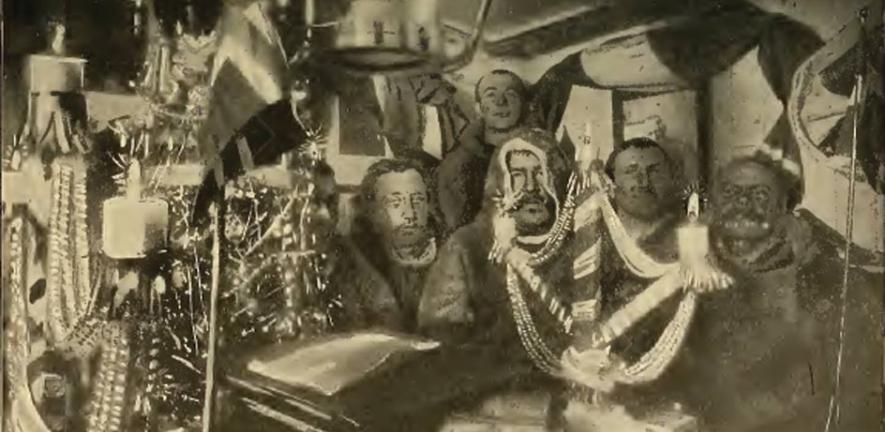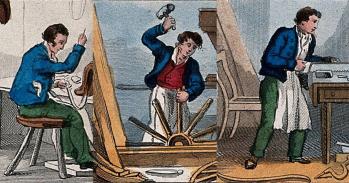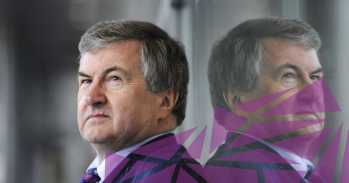
With Christmas upon us, Cambridge historian Dr Shane McCorristine and geographer and psychologist Dr Jane S.P. Mocellin take us back to the heroic age of Polar exploration, when festive celebrations served as essential emotional, psychological and nutritional functions during winter’s darkest months.
With Christmas upon us, Cambridge historian Dr Shane McCorristine and geographer and psychologist Dr Jane S.P. Mocellin take us back to the heroic age of Polar exploration, when festive celebrations served as essential emotional, psychological and nutritional functions during winter’s darkest months.
Looking back at accounts of Christmas celebrations, the diaries of explorers are full of salacious details about the food and drink served on Christmas Day, focusing especially on the quality of the roast beef and plum pudding.
Shane McCorristine and Jane Mocellin
The Christmas period is upon us once again and we are bombarded by advertisements for gifts and presents, invitations to office parties, and reminders to send Christmas cards to friends all over the world. These rituals are so familiar they are taken as a given, but historians have shown that Christmas, something that we think of as eminently “traditional”, is in fact a synthetic festival made up of various ancient, pagan, Christian, and secular winter rituals.
While others have investigated the origins of the modern Christmas in the Victorian period and the writings of Charles Dickens, it is also interesting to see how the syntheses of nineteenth-century Christmas traditions were reproduced and adapted far from ‘merrie England’, in some of the most extreme (if not unseasonal) environments on earth.
Celebrations of Christmas during nineteenth-century polar expeditions had the primary function of imitating an idealised version of Christmas back at home, thereby forging a sense of community and contemporaneity with loved ones across distant spaces. Just as at home, hair would be cut, beards shaved, and bodies, decks, and camps scrubbed and decorated in preparation for a ritualised time of relaxation. Surveying, for the first time, accounts of Christmas celebrations from a corpus of sources from the heroic age of polar exploration (c.1818-1912), we are revealing just how crucial the Christmas festival could be for the mental and physical health of explorers.
Depending on their location, expeditions over-wintering in the Arctic and Antarctica experienced lengthy periods of relative darkness and cold, resulting in rising levels of anxiety in crews due to homesickness, particularly in the run up to Christmas. For commanding officers, maintaining psychological well-being and decreased levels of anxiety among crew and officers was seen as key to a successful winter. This necessitated a suite of activities and strategies to instil senses of excitement and satisfaction (i.e., relaxation) among crews during the dark months.
The Arctic explorer William Edward Parry was something of a pioneer in this regard. In a disciplinary sense, Parry sought to battle winter through the structuring of time into watches, forcing the sailors to perform calisthenic exercises on deck, and most noticeably, dancing to the barrel organ (now on display at the Scott Polar Museum). This also had the medical reasoning that exercise could prevent scurvy, a dreaded disease long associated with winter idleness among naval commanders. Parry also realised that Christmas was a psychological venting period when expedition men and officers demanded excitement and stimulus, but could at the same time become emotional, think of loved ones, and dream of home.
Parry’s innovative strategy in this regard was institution of winter theatrical entertainments during successive Arctic expeditions in search of the Northwest Passage between 1819 and 1825. These ‘rational amusements’ were designed to keep the men busy designing sets and performing roles in order to stimulate ‘the sanguine hopes which were entertained by all on board, of the complete accomplishment of our enterprise’.
Our analysis shows how this tradition became established among Parry’s successors who similarly realised the value of ludic spaces where certain types of playful and deviant behaviour were tolerated and cherished. Alongside Christmas pantomimes and theatrical productions, historic traditions of cross-dressing, mumming and ‘blacking up’ for minstrel performances, became common on polar expeditions, while prohibitions on excessive drinking of alcohol, gambling, and the publication of satirical verse and song were relaxed, boosting the physical and mental health of the crews, if only just temporarily.
During the English Christmas, the election of saturnalian fellows like the Lord of Misrule and the Boy Bishop could reverse the master-servant relationship, and things were no different in the Poles. A diary record of one of Parry’s expeditions notes how he was disturbed on Christmas Day by the two Boatswain’s Mates, with powdered heads and brooms, who ‘begged he would receive his pipe or Silver Call, and with his permission to resign his office and take the lowest grade of duty in the ship, that of “Sweeper”! The sweepers in return took upon themselves the duty of the former, the order of things being reversed’. Customs like this show how Christmas rituals could ease tensions between officers and men and promote communal camaraderie on long stressful polar expeditions.
Christmas, like many mid-winter festivals in world cultures, was also a special time of feasting and over-indulging in foods not normally available to all. Christmas was a major nutritional event in the lives of polar explorers, satisfying a need for culinary variety and calories that was rarely met in everyday rations. Looking back at accounts of Christmas celebrations, the diaries of explorers are full of salacious details about the food and drink served on Christmas Day, focusing especially on the quality of the roast beef and plum pudding.
Poems, paeans, and elaborate menus would be composed to celebrate these foods that were seen, by British explorers, as authentic pieces of “Old England”; but they were also important sources of vitamins and calories during a mid-winter period generally characterised by depression and fatigue.
Nutrition was a major element in Robert Falcon Scott’s planning of the Antarctic Discovery expedition (1901-4), but just two months into Scott’s dash for the South Pole with Ernest Shackleton and Edward Wilson, signs of scurvy were evident. Therefore it is no surprise that the polar party looked forward to the double rations of Christmas Day 1902 with ‘childish delight’.
In Scott’s words, Christmas was a ‘delightful break in the otherwise uninterrupted spell of semi-starvation’, and the men feasted on pemmican, biscuit, seal-liver, boiling cocoa, and large spoonfuls of jam which ‘left a sense of comfort which we had not experienced for weeks’. ‘Meanwhile’, wrote Scott, ‘I had observed Shackleton ferreting about in his bundle out of which he presently produced a spare sock, and stowed away in the toe of that sock was a small round object about the size of a cricket ball, which when brought to light, proved to be a noble “plum-pudding”’.
While Scott, Shackleton, and Wilson slept well that night (‘with no dreams, no tightening of the belt’), the party were forced to turn back on December 30th due to weakness associated with scurvy. Although a few Christmas dinners were not enough to save several polar expeditions from disaster and starvation, the Christmas festival was universally anticipated as a time of relaxation, entertainment, and emotional connection with loved ones back home. Crew and officers on historic polar expeditions realised the importance of a mid-winter festival in the maintenance of general health and morale. Today, among scientists and researchers over-wintering in warm and well-stocked stations in the Arctic and Antarctic, the celebration of Christmas still retains its allure and enchantment, even if the “roast beef of old England” has made way for turkey.
Shane McCorristine is a Marie Curie Fellow (COFUND, Irish Research Council) at the Department of English, National University of Ireland Maynooth and Scott Polar Research Institute, Cambridge. He is completing a book on supernatural experience in polar exploration. For more information he can be contacted at sm877@cam.ac.uk
Jane S.P. Mocellin is a geographer and a psychologist, a seasoned polar researcher, and is currently a Senior Consultant for the United Nations Development Programme on crises prevention and recovery.
This work is licensed under a Creative Commons Licence. If you use this content on your site please link back to this page.





